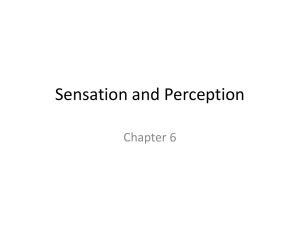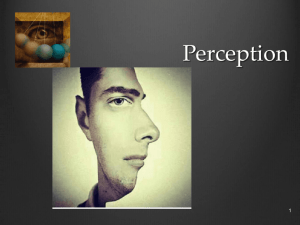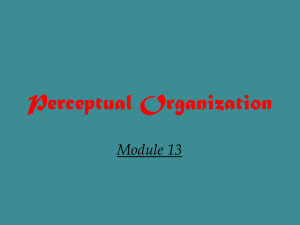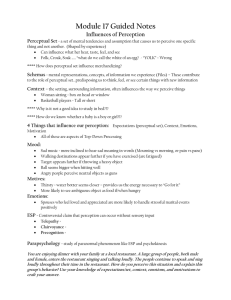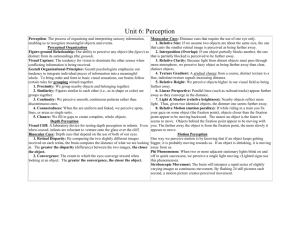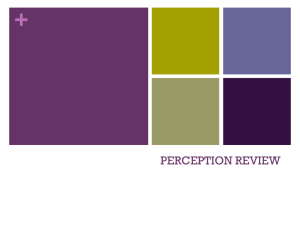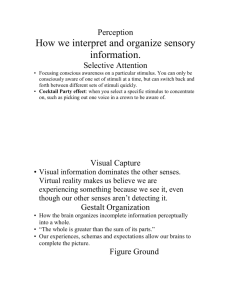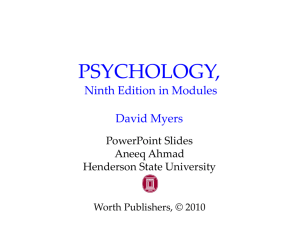Motion Perception
advertisement
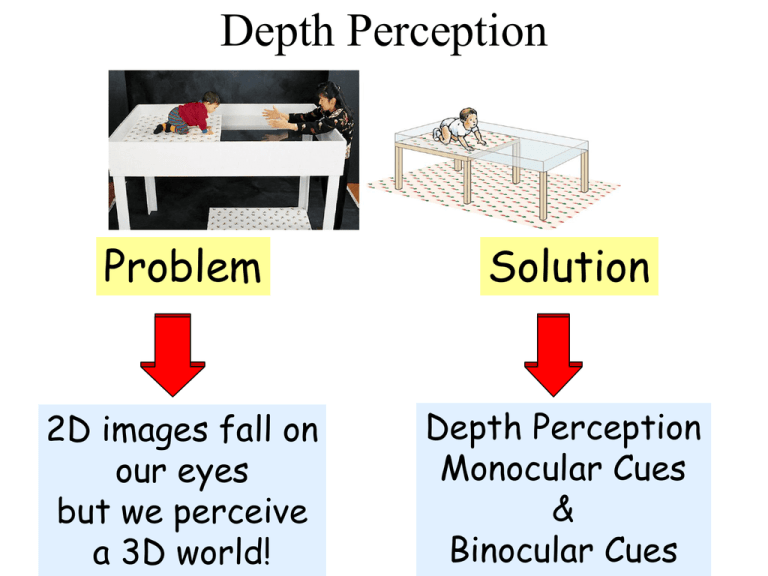
Depth Perception Problem Solution 2D images fall on our eyes but we perceive a 3D world! Depth Perception Monocular Cues & Binocular Cues Binocular Cues Retinal Disparity Diff between the two images Closer the object = the larger the disparity Convergence Degree to which eyes face inward Closer the object = the greater convergence Clues to relative distance of different objects Binocular Cues Retinal/Binocular disparity: Images from the two eyes differ. Try looking at your two index fingers when pointing them towards each other half an inch apart and about 5 inches directly in front of your eyes. You will see a “finger sausage” as shown in the inset. http://www.michaelbach.de/ot/sze_Frankfurter/index.html Stereograms http://www.netaxs.com/~mhmyers/rds-ex.html Perceptual Constancy Objects remain unchanged as their image on the retina changes • • Shape Constancy Size Constancy – looking at the same size objects close and far away – Close Object –> projects larger image on our retina. – Far Object –> projects smaller image on our retina. • Example: as a person walks away from you their retinal image decreases in size. However, we know that they are just getting farther away not shrinking in size. If two objects are similar in size, we perceive the one that casts a smaller image to be farther away Relative Size If one object partially blocks our view of another object, we perceive it as closer Interposition Monocular Cues We perceive hazy objects to be farther away than those objects that appear sharp and clear Relative Clarity Relative Brightness Nearby objects reflect more light to our eyes, so dimmer objects appear to be farther away and brighter objects seem closer Monocular Cues Indistinct (fine) texture signals an increasing distance, while coarse texture signals a close distance. Texture Gradient Parallel lines appear to converge in the distance. The more the lines converge, the greater their perceived distance. Linear Perspective Monocular Cues We perceive objects that are higher in our field of vision to be farther away than those that are lower. Relative Height Objects closer to (in front of )a fixation point move faster and in opposing direction to those objects that are farther away from (behind) a fixation point, moving slower and in the same direction. Relative Motion Monocular Cues What Cues Do You See? Optical Illusion: Ponzo The distant monster (below, left) and the top red bar (below, right) appear bigger because of size constancy and the monocular distance cues of linear perspective and texture gradient. Linear Perspective - parallel lines appear to converge in the distance. The more the lines converge, the greater their perceived distance Texture Gradient – indistinct (fine) texture signals an increasing distance, while coarse texture signals a close distance Size Constancy - If 2 objects cast identical retinal images (i.e., they are the same size), the object appearing further away is perceived as larger and so the brain perceptually enlarges the image Optical Illusion: Horizontal- Vertical Illusion The vertical line appears longer than the equally long horizontal line because of size constancy and the monocular distance cue of relative height Relative height – Objects at the top of our visual field appear to be more distant. Size constancy - If 2 objects cast identical retinal images (i.e., they are the same size), the object appearing further away is perceived as larger and so the brain perceptually lengthens the vertical line. Optical Illusion: Muller-Lyer • (a) Outward pointing arrows signify that the top horizontal line is farther and thus looks longer; while (b) inward pointing arrows signify that the horizontal line is closer and thus looks shorter. • The illusion is not cross-cultural. Non-Western subjects, and particularly subjects whose day-today surroundings are usually not rectangular (few buildings, doors, walls) are much less likely to be affected by it Motion Perception: Phi Phenomenon Phi Phenomenon: When lights flash at a certain speed they tend to present illusions of motion. Neon signs use this principle to create motion perception. Motion Perception: Stroboscopic Stroboscopic Motion – rapid sequencing of visual images Perceptual Organization “The whole is different than the sum of its parts.” Gestalt Psychology Max Wertheimer (1880-1943) Described principles by which we organize sensations into perceptions. We combine bottom-up info with top-down knowledge to create perception http://www.thepsychfiles.com/2007/10/episode-31lemon-slices-and-a-new-face-on-mars-gestaltprinciples-at-work/ Principles of Gestalt Psychology Figure & Ground (organization of the visual field into objects (figures) that stand out from their surroundings (ground)) Similarity (group figures that are similar) mom mom mom mom mom Proximity (group nearby figures together) Principles of Gestalt Psychology Connectedness (spots, lines and areas are seen as unit when connected) Continuity (perceive continuous patterns) Closure (fill in gaps) Proximity • Perceiving objects close to each other as forming a group. • Looking at the picture, since the horizontal rows of circles are closer together than the vertical columns, we perceive two vertical lines. Since the first two columns and the last two columns have less space between them than the center two columns, we perceive two groups of two columns. Closure • The principle of closure applies when we tend to see complete figures even when part of the information is missing. • Closing up or completing figures that are not, in fact, complete • We see three black circles covered by a white triangle, even through it could just as easily be three incomplete circles joined together. • Our minds react to patterns that are familiar, even though we often receive incomplete information. It is speculated this is a survival instinct, allowing us to complete the form of a predator even with incomplete information. Continuation • Perceiving smoothly flowing or continuous forms rather than disrupted or discontinuous ones. • As seen in the example, we perceive the figure as two crossed lines instead of 4 lines meeting at the center. • Even though the circle is not joined together, we still perceive a circle due to the principle of closure Similarity • The principle of similarity states that things which share visual characteristics such as shape, size, color, texture, value or orientation will be seen as belonging together. • In the example, the two filled lines gives our eyes the impression of two horizontal lines, even though all the circles are equidistant from each other. • In the example, the larger circles appear to belong together because of the similarity in size. Observer Characteristics: Experience / Culture The predominating norms, behavior patterns, artifacts, institutions, and attitudes of a group of people. In addition, past learning shapes perception. To an East African, the woman sitting is balancing a metal box on her head, while the family is sitting under a tree. 24 Observer Characteristics: Expectations Preconceptions about what we are supposed to perceive may also influence perception by causing us to delete, insert, transpose, or otherwise modify what we see. • Perceptual familiarization/generalization - strong tendency to see what we expect to see even if our expectation conflicts with external reality. • Perceptual set - a readiness to perceive a stimulus in a particular way. • Schemas -mental framework that organizes and interprets information • Context Effects - immediate context of a figure influences one’s perception of it. Expectations: Context Effects We interpret what we see based on the context in which we see it (first and last letter of word). Olny srmat poelpe can. I cdnuolt blveiee that I cluod aulaclty uesdnatnrd waht I was rdanieg. The phaonmneal pweor of the hmuan mnid, aoccdrnig to rscheearch at Cmabridgde Uinervtisy, it deosn’t mttaer in what oredr the ltteers in a word are, the olny iprmoatnt tihng is that the frist and lsat ltteer be in the rghit pclae The rset can be a taotl mses and you can still raed it wouthit a porbelm. This is bcuseae the huamn mnid deos not raed ervey lteter by istlef, but the word as a wlohe. Amzanig huh? Yaeh and I awlyas tghuhot slpeling was ipmorantt! 26 Expectations: Context Effects Dear Mother and Dad: Since I left for college I have been remiss in writing and I am sorry for my thoughtlessness in not having written before. I will bring you up to date now, but before you read on, please sit down. You are not to read any further unless you are sitting down, okay? Well, then, I am getting along pretty well now. The skull fracture and the concussion I got when I jumped out the window of my dormitory when it caught on fire shortly after my arrival here is pretty well healed now. I only spent two weeks in the hospital and now I can see almost normally and only get those sick headaches once a day. Fortunately, the fire in the dormitory, and my jump, was witnessed by an attendant at the gas station near the dorm, and he was the one who called the Fire Department and the ambulance. He also visited me in the hospital and since I had nowhere to live because of the burntout dormitory, he was kind enough to invite me to share his apartment with him. It’s really a basement room, but it’s kind of cute. He is a very fine boy and we have fallen deeply in love and are planning to get married. We haven’t got the exact date yet, but it will be before my pregnancy begins to show. Yes, Mother and Dad, I am pregnant. I know how much you are looking forward to being grandparents and I know you will welcome the baby and give it the same love and devotion and tender care you gave me when I was a child. The reason for the delay in our marriage is that my boyfriend has a minor infection which prevents us from passing our premarital blood tests and I carelessly caught it from him. I know that you will welcome him into our family with open arms. He is kind and, although not well educated, he is ambitious. Although he is of a different race and religion than ours, I know your often expressed tolerance will not permit you to be bothered by that. Now that I have brought you up to date, I want to tell you that there was no dormitory fire, I did not have a concussion or skull fracture, I was not in the hospital, I am not pregnant, I am not engaged, I am not infected, and there is no boyfriend. However, I am getting a “D” in American History, and an “F” in Chemistry and I want you to see those marks in their proper perspective. Your loving daughter, Sharon Expectations: Perceptual Familiarization/Generalization 28 Expectations: Schemas • Provide punctuation that will make the following words meaningful: • TIME FLIES I CANT THEYRE TOO FAST • The apostrophes come easily, but the rest is difficult. TIME FLIES. I CAN’T. THEY’RE TOO FAST. It still does not seem to make sense because we’re too familiar with the slogan, “Time flies” in which “time” is a noun and “flies” is a verb. Tell students to read “time” as the verb and “flies” as the noun. It now makes perfect sense. 29 Expectations: Perceptual Set (a) Lochness monster or a tree trunk; (b) Flying saucers or clouds? 30 Expectations: Perceptual Set • Sine Wave Speech – http://www.lifesci.sussex.ac.uk/home/Chris_Da rwin/SWS/ – http://www.mrccbu.cam.ac.uk/people/matt.davis/sine-wavespeech/ • Backmasking – http://jeffmilner.com/backmasking.htm – http://www.youtube.com/watch?v=Qwiba6_LY P0 31 Observer Characteristics: Cognitive Style • COGNITIVE STYLE: Way of processing the stimuli within the environment, which affects how we see the world. Pg. 454 H:3-4 Demo – – Field-dependent approach = perceive the environment as a whole and do not clearly distinguish in their minds the shape, color, size, or other qualities of individual items. No details. “Levelers” Field-independent approach = perceive the elements of the environment as separate and distinct from one another and to draw each element as standing out from the background. A lot of details. “Sharpeners” Observer Characteristics • • • VALUES: What we deem as important will shape our perceptions. PERSONALITY: Person’s unique pattern of thoughts, feelings, and behaviors affect perception. MOTIVATION: Our desires and needs strongly shape our perceptions. People in need are more likely to perceive something that they think will satisfy that need.
